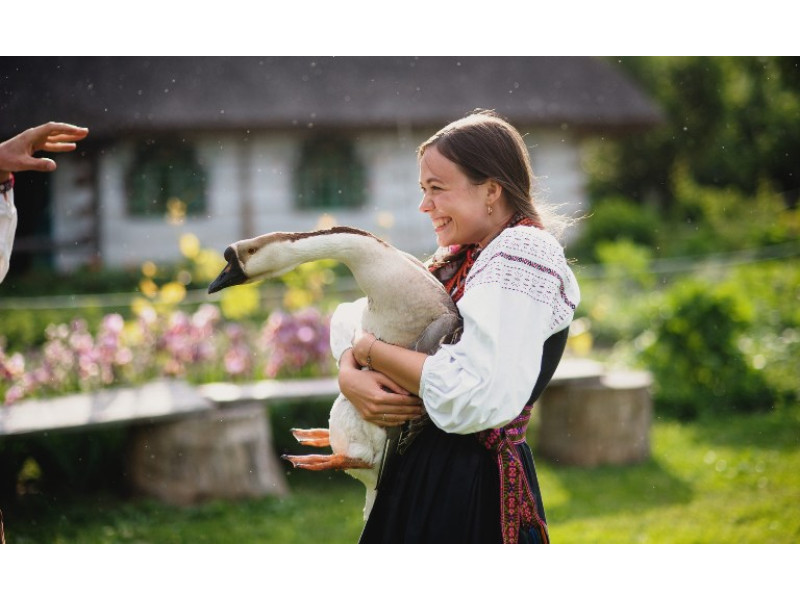A small farmstead with its typical Ukrainian lifestyle and things, domestic animals, a vegetable garden, all that is familiar to rural residents and unlikely to surprise them, can be a real surprise and adventure for city dwellers. Especially if you can not only see all this, but also feel like a participant in everything that is happening around you.
This is the opportunity to become a part of folk culture, to touch its roots, to get to know it, as they say, from the inside, you will certainly have if you visit the unique ethnographic museum - "Khutir Savky", which is located near Kyiv. Some 10-15 minutes, and you will find yourself in the courtyard of an old house, standing on the outskirts of the village of Novi Petrivtsi.
History of the museum
The history of the museum, although not very long, is certainly interesting. And it began in 2003, when a resident of Kyiv, Leonid Shilov, opened his family business - the development of a museum complex. A strange business at first glance, but it immediately captivated and aroused great enthusiasm among the entire family - his wife, son and daughter.
And the name of the Farm was not chosen by chance, because Sava Ivanovich, Savka, as everyone called him, was the owner's grandfather. He lived not far from the place where his grandson built the farm, named after his grandfather. He was a strong, wealthy, and also intelligent and foresightful owner, which helped his family survive the famine in difficult times. Grandfather's house, unfortunately, has not survived, so the museum was created as a tribute to the memory of his grandfather-worker, as a desire not to completely lose things dear to his heart. A lamp, a chest, a bench - these things that Grandfather Savka once used are now carefully stored in the house, as part of the museum exposition.
"Khutir Savky" is a historical complex that includes two authentic huts. One of them, from 1786, is located in its original place and once belonged to a wealthy peasant. The date of construction, carved on a beam, has been preserved to this day. It was with the acquisition of this rarity from a ninety-year-old single grandmother Maria that the future museum began. The hostess almost did not take care of her home in the last years of her life, so the dwelling was neglected, with a clogged chimney, in which mice settled, and walls black with soot.
The hut was repaired and restored, and in 2004 the first visitors were able to see it.
Almost immediately, the hut began to be filled with antique household items, and around it appeared outbuildings that were an integral part of village life. A gypsy forge, a barn, a cellar, a well, and beehives - all of these became museum exhibits.
The second house, built in 1854, came to Novi Petrivtsi later, it was moved by the owners in 2008. It was once a manor house in the village of Meleni in the Zhytomyr region and belonged to the noble families of Vasyanovich and Stretovych. The house was dismantled into parts and, carefully numbering and neatly stacking each log, was transported to a new place. And here, carefully looking at old photographs, they put it together again, trying to put everything together as it was done by craftsmen a century ago.
Thus, the old village hut, half-destroyed by time, found its new life and, in the caring hands of its new owners, along with other exhibits, turned into "Savka's Farm".
What is surprising about "Khutir Savky"?
Today, the museum complex surprises its guests, and this is exactly how its owners treat visitors, with a large number of authentic antique household items, utensils, and clothing from different parts of Polissya, which is in northern Ukraine.
Some of them were left in the yard by their old owners. For example, a forged needle that Grandma Maria once used to sew for her relatives, or old, handmade boots.
But the owner has been collecting the vast majority of the numerous exhibits for a long time and continues to do so, because it is impossible to collect everything. Even things that seem the same at first glance turn out to be different, either in size, or in the material they are made of, or even in their purpose. Each of them is unique, each has its own story. How can I stop here?
So in one place, forks, axes, rakes, scythes, hammers, mortars, scales, barrels, and various clay vessels, which were made at different times and used in their homes by ordinary people, gathered in a pile. The people are no longer there, but the things live on and remind us of their owners.
The museum has weaving and carpentry workbenches, a potter's wheel, a spinning wheel, a millstone, etc. There are also scales from 1795, which were accidentally found in a pantry, and axes with numbers that a master forged on them long ago.
You can visit the apiary, which houses various beehives made over the past three centuries, as well as beekeeper tools, and visit a shoemaker's workshop, where shoes from different eras are collected.
They will show you a mortar that looks like the equipment of the fairy-tale Baba Yaga, a tub in which bread dough is kneaded, a shovel with which bread is put into the oven, and the oven itself. You can also see the oldest exhibits - an axe that has survived to our times since the Stone Age, and grain grown from what lay in a pot buried in the ground, about six thousand years ago, from the Trypillian times.
In the house, cradles hang from the ceiling. They are also different - one is wooden, hollowed out, the other is made of some kind of strong fabric like tarpaulin. The walls are decorated with ancient icons, paintings, embroidered towels. Chests with a bride's dowry stand near the wall. Books and magazines printed in the 19th and 20th centuries are kept here, as well as ancient children's toys.
There is a real barn in the yard. It is already 155 years old, but it is still used by the owners of the farm, which is why the smell here is extraordinary - it smells of dry herbs and clay. In addition, the barn is full of amazing things. There is an old washing machine (zhlukto) and barrels that were made from a whole log, hollowed out, and in which grain was stored. And next to it is the same axe that these barrels were hollowed out with. And there is also a purely Ukrainian product, because where else could a special separate barrel for storing lard, covered with salt, appear, if not here. Bottles with delicious tinctures and liqueurs are stored here, plugged with a corncob instead of a lid, braids of onions and garlic hang, bunches of dried healing herbs are laid out.
And from the stones left over from his grandfather's old mill, the owner laid out a kind of calendar snake.
Living museum
Savky's Farm is significantly different from most similar ethnographic museums – its highlight is that all its exhibits are not only not hidden under glass, but are active. They can be held in your hands and tried out in practice.
Here you can see with your own eyes how a real forge works with blacksmithing equipment from the 18th-20th centuries, where bellows are inflated, a forge is heated, and hammers are pounded on an anvil. And if you want, you can try hitting hot iron with a hammer yourself.
If you are curious about how our great-grandmothers did laundry in ancient times, you can soak your clothes in ash on the river and wash them by beating them with a wooden washcloth.
And the hosts will teach you how to grind flour with your own hands on stone millstones, how to spin threads from flax and hemp, how to sharpen a scythe, shoe a horse, knead clay, and take you on a ride on a Chumat cart.
Here you can watch wonderful folk craftsmen, potters, and carvers at work, and, if you wish, even take part in interesting master classes in pottery, carving, straw weaving, glass painting, etc.
And if your soul, having touched the Ukrainian past, desires songs, folklore groups will gladly delight you with their art.
It is especially interesting for little ones, because for children every little thing here is a real discovery, and the opportunity to touch everything or do something yourself is an incomparable experience that you will never get sitting at home at the computer.
The authenticity of the Farm has also attracted the attention of Ukrainian filmmakers, who are shooting historical films here based on the works of Lesia Ukrainka and Olga Kobylyanska.
Ukrainian hospitality
At Savky Farm, guests are always welcome, so they are greeted in the Ukrainian way - with the whole family, coming out to meet them in national costumes, with bread and salt.
And then begins an amazing action that immediately transports you to the past of a Ukrainian village with its everyday life and holidays. And all this is interestingly told, shown, and explained, and the mixture of legends, anecdotes, fables, and proverbs, without which no excursion is complete, makes everything that happens even more interesting.
And after the tour, you will be invited to taste Ukrainian food prepared according to old recipes, and even in a real oven and in clay pots.
The table is set right in the house, in the living room, under the icons with towels, as has long been customary in Ukraine. Home-spun tablecloths, a two-hundred-year-old bench by the wooden table add to the mood and appetite. And there is really something to taste here: borscht, and even with garlic dumplings, dumplings with various fillings, roast with mushrooms and meat, sausages, and dumplings. And all this from the oven - from the dust, from the heat, and in a clay bowl with a wooden spoon. And to top off all this deliciousness, there is also uzvar, nalyvochki or fragrant herbal tea.
And they will definitely tell you about the rituals and customs our grandfathers and great-grandfathers followed when they sat down at the table, how they respected bread, how they treated it with care.
"Khutir Savky" is a wonderful place where you can touch the origins of Ukrainian culture, get incredible impressions from folk traditions, and acquire unique skills. It is advisable to come here with the whole family or with friends. Here you can take part in folk ritual holidays and organize your own unforgettable holidays - birthdays and weddings.
The museum is located in the village of Novi Petrivtsi, which is six kilometers from Kyiv, if you drive along Minsk Avenue (by your own car or by minibus No. 795 from the "Heroes of the Dnieper" metro station or from Taras Shevchenko Square).
Guests are always welcome at Savky's Farm, but as the saying goes, "an uninvited guest is worse than a Tatar," so make arrangements with the hosts in advance by phone, and then they will definitely wait for you and give you a real miracle.
Official website of the museum: http://xutir-savky.com.ua/



















Write a comment